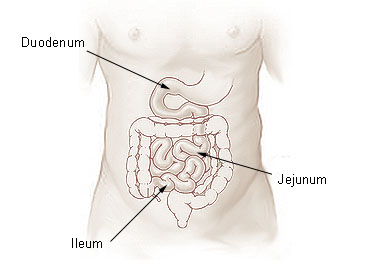The small intestine is the part of the gastrointestinal tract where much of the digestion and absorption of food takes place.
The Small Intestine
The small intestine is the part of the gastrointestinal tract that follows the stomach, which is in turn followed by the large intestine. The small intestine is the site where almost all of the digestion and absorption of nutrients and minerals from food takes place.

Small intestine: An illustration of the small intestine with the duodenum, jejunum, and ileum labeled.
The average length of the small intestine in an adult human male is 6.9 m (22 feet, 6 inches), and in the adult female 7.1 m (23 feet, 4 inches). It can vary greatly, from as short as 4.6 m (15 feet) to as long as 9.8 m (32 feet). The small intestine is approximately 2.5–3 cm in diameter, and is divided into three sections:
- The duodenum is the first section of the small intestine and is the shortest part of the small intestine. It is where most chemical digestion using enzymes takes place.
- The jejunum is the middle section of the small intestine. It has a lining which is designed to absorb carbohydrates and proteins. The inner surface of the jejunum, its mucous membrane, is covered in projections called villi, which increase the surface area of tissue available to absorb nutrients from the gut contents. The epithelial cells which line these villi possess even larger numbers of microvilli. The transport of nutrients across epithelial cells through the jejunum includes the passive transport of some carbohydrates and the active transport of amino acids, small peptides, vitamins, and most glucose. The villi in the jejunum are much longer than in the duodenum or ileum.
- The ileum is the final section of the small intestine. The function of the ileum is mainly to absorb vitamin B12, bile salts, and any products of digestion that were not absorbed by the jejunum. The wall itself is made up of folds, each of which has many tiny finger-like projections known as villi on its surface. The ileum has an extremely large surface area both for the adsorption of enzyme molecules and for the absorption of products of digestion.
The Villi
The villi contain large numbers of capillaries that take the amino acids and glucose produced by digestion to the hepatic portal vein and the liver. Lacteals are the small lymph vessels that are present in villi. They absorb fatty acids and glycerol, the products of fat digestion, into direct circulation.
Layers of circular and longitudinal smooth muscle enable the digested food to be pushed along the ileum by waves of muscle contractions called peristalsis. The undigested food (waste and water) are sent to the colon.

